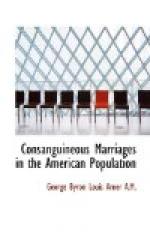Same-name first cousin marriages 24 1 1 ------------------------------------- = -- = -------- = ------- Different-name first cousin marriages 62 (2-7/12) 2.583
This is near the ratio which Darwin obtained from his data, and which he finally changed to 1/4. I am inclined to think that his first ratio was nearer the truth, for since we have found that the coefficient of attraction between cousins would be so much greater than between non-relatives, why should we not assume that the attraction between cousins of the same surname should exceed that between cousins of different surnames? For among a large number of cousins a person is likely to be thrown into closer contact, and to feel better acquainted with those who bear the same surname with himself. But since the theoretical ratio would be about 1/4 it would hardly be safe to put the probable ratio higher than 1/3, or in other words four first cousin marriages to every same-name first cousin marriage. Our revised formula then is:
All same-name marriages 3 1 --------------------------- = --- X --- = .75 All first cousin marriages 1 4
Instead of Mr. Darwin’s .35.
Taking then the 10,198 marriages, with their 2.07 per dent of same-name marriages, and dividing by .75 we have 2.76 per cent, or 281 first cousin marriages.
In order to arrive at approximately the percentage of first cousin marriages in a nineteenth-century American community I counted the marriage licenses in Ashtabula County, Ohio, for seventy-five years, (1811-1886). Out of 13,309 marriages, 112 or .84 per cent were between persons of the same surname. Applying the same formula as before, we find 1.12 per cent of first cousin marriages, or less than half the percentage found in eighteenth-century New York. This difference may easily be accounted for by the comparative newness of the Ohio community, in which few families would be interrelated, and also to that increasing ease of communication which enables the individual to have a wider circle of acquaintance from which to choose a spouse.
Adopting a more direct method of determining the frequency of cousin marriage, I estimated in each of sixteen genealogical works, the number of marriages recorded, and found the total to be 25,200. From these sixteen families I obtained 153 cases of first cousin marriage, or .6 per cent. Allowing for the possible cases of cousin marriage in which the relationship was not given, or which I may have over-looked, the true percentage is probably not far below the 1.12 per cent obtained by the other method.
The compiler of the, as yet, unpublished Loomis genealogy writes me that he has the records of 7500 marriages in that family, of which 57 or .8 per cent are same-name marriages. This would indicate that 1.07 per cent were between first cousins.




